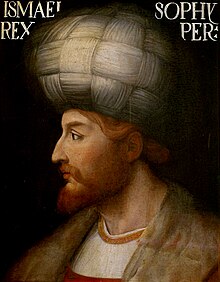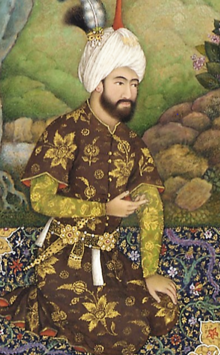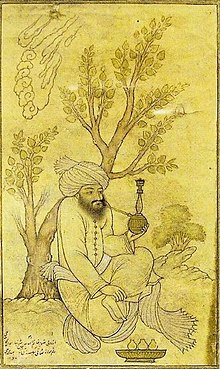User:HistoryofIran/Safavid conversion of Iran to Shia Islam
| This is a Wikipedia user page. This is not an encyclopedia article or the talk page for an encyclopedia article. If you find this page on any site other than Wikipedia, you are viewing a mirror site. Be aware that the page may be outdated and that the user in whose space this page is located may have no personal affiliation with any site other than Wikipedia. The original page is located at http://en.wikipedia.org/wiki/User:HistoryofIran/Safavid_conversion_of_Iran_to_Shia_Islam. |

Following their rise to power in Iran in the 16th century, the Safavid dynasty initiated a campaign of forced conversion against the population of Iran, seeking to create a new demographic environment in which Shia Islam would replace Sunni Islam as the nation's religious majority.
Background
[edit]After the Islamic prophet Muhammad died in 632, a group of followers ("Shia") of his cousin Ali proclaimed the latter as the legitimate heir and caliph. But the hopes of this group were not achieved for thirty years, during which time Abu Bakr, Umar, and Uthman—three of the Prophet's Companions—became caliphs. Sunni Islam was eventually represented by these caliphs. Their adherents claimed that they represented the Sunnah ("the right path"), that the vast majority of Muslims believed in. This was opposed by Ali and his followers, who also objected to the ways that Umar and Uthman had spread Islam in ways that were not consistent with the sayings of Muhammad and the Quran. According to Shia Islam, the lineage of authority starts with Ali (who is the first Shia Imam) and continues through his descendants of his union with Muhammad's daughter Fatima.[1]
The twelfth and last Shia Imam, Muhammad al-Mahdi, left no offspring. In 873, he either vanished or hid himself. He is regarded by Shia Muslims as the Mahdi (Messiah), and they eagerly await his return to establish what they consider rightful Shia rule.[1] Shia Islam has been infused with a martyrdom and sorrow cult since its founding. Additionally, it has sparked a number of messianic groups that have had a significant impact on Islamic history. One of these groups was the Safavid order, who endorsed Twelver Shia Islam.[2]
History
[edit]Under Ismail I
[edit]
During the reign of the first Safavid shah (king), Ismail I, the military, political, and religious goals of the Safavids became unified.[3] He proclaimed himself the King of Kings and the creator of a new Shia state in March 1501. He shortly afterwards decreed that all mosques in his domain use the Shia version of the Islamic call to prayer. In order to establish the legitimacy of Ali, the first Shia Imam, and his lineage, the additional word in this variant, "I witness that Ali is God's friend," was added. A Shia call to prayer was heard from the minarets (tower of a mosque) of an Islamic state for the first time since the 11th-century. Abu Bakr, Umar, and Uthman were also ordered to be openly insulted by Ismail I's subjects according to a royal proclamation that stated, "Whoever disobeys, he is to beheaded."[4]
Ismail I implemented significant reforms in the Persian court and its administrative branches, and to achieve his aims he relied on the Qizilbash, a group of Turkoman soldiers.[3] In addition to the risky actions of the Qizilbash under Ismail I's command, his support of Arab Shia jurists, initially from northern Syria and then from southern Iraq and the Arabian Peninsula, enhanced his anti-Sunni policies.[4] Prior to this, "even the basics of the Shia law were not known; nor were the rules and rituals of the rightful Twelver Shia sect," according to the Safavid-era historian Hasan Beg Rumlu, who almost lived during the same period as Ismail I.[4]
Before the rise of Ismail I, most Iranians believed that Shia Islam was meant to honor the family of Muhammad rather than adhering to a doctrine dictated by Shia jurists. The only exception was in small areas in Khorasan, Gilan, and central Iran.[4] Ismail I used many tactics early in his reign to establish his authority and convert his subjects to Shia Islam, with the aim of creating a Shia state and society. He used intimidation and coercion, possibly more out of pragmatism than faith, to wage war against his numerous opponents to the east and west. Additionally, by assigning clerics as delegates to the recently captured areas, he expanded Shia Islam.[5]
Any opposition from the populace was met with severe repercussions. Thousands, maybe even 20,000, of Sunnis were killed at Tabriz when there first appeared opposition to the Safavids' forcible conversion. Once their Sunni religious leadership was frightened or, more commonly, killed, the populace, primarily from the Sunni Shafi'i school, would usually cooperate. Ismail I put to death several Sunni judges, preachers, and officials who were protesting in the cities of Shiraz and Isfahan, which had been conquered by the Safavids in 1503.[5]
Under Tahmasp I
[edit]
In 1524, Ismail I was succeeded by his son Tahmasp I (r. 1524–1576). It was during his rule that Shia Islam in Iran solidified itself. The ulamas standing as guardians of Twelver Shia Islam became stronger as Tahmasp I became more autonomous, while the Qizilbash's messianic beliefs became less prominent. The religious rites and customs that would later become unique to Shia Islam started to be embraced by the Shia society.[6]
Under Ismail II
[edit]
Tahmasp I was succeeded by his son Ismail II (r. 1576–1577), who immediately decided to overturn many of the religious policies established by his father and grandfather. He opted for a kinder approach toward Sunnis and attempted to halt the anti-Sunni propaganda that had gained popularity under his father. There are several theories about why Ismail II tried to bring back Sunni Islam.[7]
The country still had many followers of Sunni Islam. In the Safavid capital of Qazvin, the sermons of the scholar Makhdum Sharifi Shirazi gathered a large audience.[8] The pro-Sunni actions that Ismail performed are attributed by Safavid records to Makhdum Sharifi Shirazi. According to Shia literature, Makhdum Sharifi Shirazi is the archenemy of Shia Islam, influencing Ismail II.[9] Makhdum Sharifi Shirazi was the grandson of Tahmasp I's vizier Qadi Jahan Qazvini and claimed the prominent Sunni scholar al-Sharif al-Jurjani as his ancestor. The study of tradition and Quranic interpretation was Makhdum Sharifi Shirazi's primary education. Building a strong relationship with Ismail II, he was appointed as the co-sadr (highest religious authority) with Shah Enayatollah Esfahani, who had previously served as the military chaplain under Tahmasp I.[10]
Ismail II worked with Makhdum Sharifi Shirazi to undo some of the Shia Islamic customs that had been practiced since the early Safavid era. These included the customary insulting of Abu Bakr, Umar, and Uthman, as well as the slander of Muhammad's wife Aisha. During debates, Ismail II actively supported Sunni arguments against the Shia ulama multiple times, thus weakening their standing and making them targets of mockery. Although the Shia ulama stayed out of Ismail II's way, they privately opposed his policies.[10]
Under Mohammad Khodabanda
[edit]Ismail II was succeeded by Tahmasp's eldest son Mohammad Khodabanda (r. 1578–1587), under whom Twelver Shia Islam was restored as the official religion of the realm.[11]
Under Abbas the Great
[edit]
During the reign of Ismail I and Tahmasp I, there was minimal interest in collections of Shia tradition, with the exception of the writings of Husayn ibn Abd al-Samad. There was a greater push to expand and preserve Shia tradition under Abbas I the Great. Shia tradition was the subject of writings by authors such as Baha al-Din al-Amili, Mir Damad, and Sayyed Ahmad Alavi. A new Persian translation of Muhammad ibn Ya'qub al-Kulayni's influential Usul al-Kafi fi 'Ilm al-Din was also published during the reign of Abbas I. The juridical encyclopedia that was most widely used was Jame-e Abbasi by Baha al-Din al-Amili, which Abbas I had ordered. It covered topics such as Islamic customs, the correct birth and death dates of the Imams, monetary donations, sales, marriage, divorce, vows, atonement, and criminal law. Abbas I instructed that Jame-e Abbasi be delivered in "a clear, comprehensible language in order that all people, the learned and the lay, would seek benefit from it," in a deliberate attempt to provide an example of Persianized Shia Islam to the Iranians.[12]
The works that Abbas I commissioned catered to a broad audience, in contrast to the expert texts written by the ulama. Jame-e Abbasi marked a turning point in the spread of Shia legal literature by promoting unification throughout the realm.[12] Around 1614, Abbas I appears to have forced Christians and Jews to convert to Islam and converted a number of churches in Georgia to mosques. Approximately 30,000 Georgian prisoners were forced into becoming Muslims between 1614 and 1616. Abbas I did not have a consistent policy towards non-Muslims in his empire. Instead, he adjusted his approach based on the specific historical situations and what was politically beneficial at the time.[13]
Under Soltan Hoseyn
[edit]
The status, practices and reception of the Shia ulama
[edit]
Even after two centuries of Persianization, the cultural orientation of the Shia ulama remained largely unchanged. Masquerading with their madrasa (religious school) education, they displayed an anti-intellectual attitude through a strong focus on hadith, conservatism, ritualistic practices in Shia Islam, opposition against diversity, and a heavy emphasis on the stories of the Imams' suffering. It was characteristic of their sociocultural stance that they were hostile to Persian literary and artistic endeavors and treated even ordinary Shia Muslims with disrespect. The Shia ulama were seen with significant uncertainty by the Iranian population. They were scorned for their perceived arrogance, hypocrisy, and greed, yet respected for their intricate knowledge and esteemed position, all of which is prominently depicted in Persian literature. Nevertheless, the Safavid shahs, from Tahmasp I to Soltan Hoseyn, approved of the ulama's conservatism.[14]
The ulama became very wealthy due to the Safavids' vast endowments for religious learning, particularly under Abbas I, but that also made them further subordinate to the state's interests. There were occasional quarrels, for instance, about wine drinking and the patronage of such practices prohibited in Islam as music and painting, or about the deviant sexual habits of the royal family, but these were not serious enough to cause a refit between the religious establishment and its royal benefactor. Sometimes, disagreements emerged over practices such as wine consumption, the support of activities prohibited in Islam like music and painting, and the atypical sexual behaviors within the royal family. Nevertheless, these disagreements were insufficient to cause a significant breach between the monarchy and the ulama.[14]
The ulama opposed other beliefs such as Agnosticism, Sufi orders like the Qalandariyya, mystics, philosophers, Sunni Islam, Judaism, Zoroastrianism, and Christianity. The ulama considered deviation from religious norms to be sinful and unsafe, especially if it resulted in the disregard of superstitious and religious behaviors. Rituals like bodily cleansing, an obsession with impurities, and detailed rules for prayer and fasting were, in the jurists' view, essential to true faith and used to control the public. As the moral police of the state, the ulama controlled education and free time, encouraged faithfulness, and reinforced the gap between the "saved" Shia and the "damned" beliefs.[15]
Even when bolstered by the holy status of the hadith, social control measures were not fully formed until the rise of Majlesi. Judiciaries often and thoroughly criticized music and dancing, whether performed for entertainment or at Sufi gatherings, because they were still popular forms of artistic expression and pastime. They also denounced breaking traditional sexual standards, women stepping outside of the harem, the drinking of wine (which was frequently portrayed in art of the time), and, most all, the overlooking of religious rituals in public.[16]
Even though seminarians and jurists frequently criticized tea and coffee shops, they continued to be much-liked hangouts for poets and artists as well as hubs of artistic innovation. Instead of mosques and stories of Shia hardship, many Muslims instead chose to go to public spaces and coffee shops, so that they could listen to the narration of the Persian epic poem Shahnameh by storytellers. Stories of the adventures of Rostam, such as his fight with the Div-e Sepid on Mount Damavand, as well as the romance about the Sasanian ruler Khosrow II (r. 590–628) and princess Shirin by Nizami Ganjavi, were among the tales they could hear.[17]
Immigration of Arab Shia scholars from Jabal Amil
[edit]
The Arab Shia scholars of Jabal Amil in Southern Lebanon proved to be eager allies and supporters for Ismail I and his advisors. After years of persecution in their own country by the Mamluks and then the Ottomans, they found a benefactor in Ismail I and a place of luxury and esteem in Safavid Iran.[18] The Amilis (and Arab scholars from other regions) were intentionally placed in important religious and quasi-administrative positions by the early Safavid Shahs, so that they could spread their well-defined Islamic creed rooted in the Shia school of thought (madhhab). Popular amongst Shia scholars, the Amilis were supported by the Safavids so that they could provide their rule with legitimacy.[3] The Amilis were strangers to Iran, did not speak Persian, and were unfamiliar with the customs and traditions of their new home. This was in contrast to the native Shia ulama of Iran, or those Sunni jurists and dignitaries who converted to Shia Islam under pressure or to preserve their advantages. Therefore, establishing a network of regional ties separate from the Safavid state proved challenging for them.[18]
The Amilis were also active in the internal Turkmen-Persian tensions that frequently erupted during and after Ismail I's reign. Despite their resistance, the Qizilbash chiefs and Arab ulama could not prevent the indigenous Persian element from gaining prominence. They were ultimately compelled to adhere to the laws of the transforming Safavid state, which was changing from a messianic crusade to a bureaucratic state. An Iranian imperial empire was envisioned when the Safavids began their campaign of conquest and Shia Islam conversion.[18]
During the first half of the 16th-century, three prominent Amili scholars of the made significant contributions to the advancement of the Safavid religious hierarchy and clerical leadership. This includes al-Muhaqqiq al-Karaki (died 1533), Husayn ibn Abd al-Samad (died 1576), and Husayn al-Mujtahid (died 1592/93). Among them, al-Muhaqqiq al-Karaki was the most powerful Amili court scholar. As an innovator, he faced challenging duties and, through his successful approval of how different laws were to be interpreted, provoked opposition from Arab and Persian ulama as well as controversy among the elite.[19]
The Amilis, like other state-appointed officials, perceived themselves collectively as guardians of an established orthodoxy. They encouraged people to understand the teachings and beliefs thoroughly and to perform rituals in a structured and organized way. The Amilis constructed new connections and provided relevant explanations for how interpreting the past in Twelver Shia history. A process of Persianization across different social classes and within government structures accompanied the spread of Shia Islam, thus shaping an unique form of Iranian Shia Islam.[20]
Several interconnected elements were prominent in Safavid society by the later 16th century, which was greatly influenced by Twelver Shia Islam. The dynastic and political goals of the shahs had become more clear. Clerical Shia Islam was started to be adopted by the elites who had previously resisted it. In order to gain authority and instill public compliance to clerical decisions across different ethnic and social groups, the Amilis would borrow aspects of Iran's culture. With the Amilis acting as their representatives, the Safavids significantly shaped Iranian legal and doctrinal traditions and altered the political landscape of Iranian society.[21]
The reaction of the Sunni ulama
[edit]The Sunni Ottomans in the west and the Sunni Uzbek tribes in the east were especially angered by the Safavid support of Shia Islam. The Sunni ulama (clergyhood) were called upon to answer to the challenge posed by the rise of Twelver Shia Islam. They published polemics, issued fatwas, and exchanged letters with the Shia ulama and rulers.[22]
The impact on philosophers
[edit]The jurists' attacks on philosophers diminished much of their influence.[17]
Celebrations of Nowruz and Ashura
[edit]Under the Safavids, jointly celebrating Nowruz (Iranian New Year) and Ashura (mourning the death of the third Shia Imam Husayn ibn Ali) gained prominence and built the groundwork for the Iranian-Shia identity that persisted for more than 500 years. Since in 963 in Baghdad under the Buyid ruler Mu'izz al-Dawla (r. 945–967), Ashura had been introduced to the festivities surrounding Nowruz and Mehragan. The creation of several customs ascribed to Shia Imams from the Buyid to the Safavid eras gave Nowruz religious legitimacy. According to historical accounts, the majority of Iranians celebrated Nowruz, even in the face of opposition from Islamic fundamentalists.[23]
Historical significance
[edit]The Reformation in northern and central Europe and the Counter-Reformation that followed it are comparable to the state-sponsored Shia Islam that resulted from the advent of the Safavids and the Sunni response to it. The split that resulted between the Sunnis and Shias is similar to the Protestant-Catholic split that accelerated the formation of nation-states in Europe.[24] The emergence of the Safavid state and its adoption of Shia Islam as the official faith was a pivotal moment that significantly affected both Iran and the surrounding Sunni-majority regions.[25] The conversion to a state-sponsored religion, in this case Shia Islam, provided the bond required to hold together the fundamental elements of Safavid state, similar to other early states such as Spain and England.[26] Iran was largely shaped into a geographical empire with a unique identity due to the fusion of religious and political elements by the Safavid dynasty.[27]
References
[edit]- ^ a b Abisaab 2004, p. 7.
- ^ a b Amanat 2017, p. 34.
- ^ a b c Abisaab 2004, p. 8.
- ^ a b c d Amanat 2017, p. 33.
- ^ a b Amanat 2017, p. 47.
- ^ Amanat 2017, p. 62.
- ^ Abisaab 2004, p. 41.
- ^ Newman 2013, p. 160.
- ^ Abisaab 2004, pp. 43–44.
- ^ a b Abisaab 2004, p. 44.
- ^ Newman 2013, p. 161.
- ^ a b Abisaab 2004, p. 58.
- ^ Abisaab 2004, p. 63.
- ^ a b Amanat 2017, p. 122.
- ^ Amanat 2017, p. 123.
- ^ Amanat 2017, pp. 123–124.
- ^ a b Amanat 2017, p. 124.
- ^ a b c Amanat 2017, p. 48.
- ^ Abisaab 2004, p. 9.
- ^ Abisaab 2004, p. 5.
- ^ Abisaab 2004, p. 10.
- ^ Maryam 2017, p. 5.
- ^ Ashraf & Gnoli 2020.
- ^ Amanat 2017, pp. 37–38.
- ^ Amanat 2017, pp. 33–34.
- ^ Amanat 2017, p. 75.
- ^ Amanat 2017, p. 59.
Sources
[edit]- Abisaab, Rula Jurdi (2004). Converting Persia: Religion and Power in the Safavid Empire. I.B.Tauris. ISBN 978-1860649707.
- Amanat, Abbas (2017). Iran: A Modern History. Yale University Press. ISBN 978-0300112542.
- Ashraf, Ahmad; Gnoli, Gherardo (2020). "Iranian Identity". Encyclopaedia Iranica Online. Brill. Retrieved 15 July 2024.
- Maryam, Moazzen (2017). Formation of a Religious Landscape: Shi‘i Higher Learning in Safavid Iran. Brill. ISBN 978-9004355293.
- Newman, Andrew J. (2008). Safavid Iran: Rebirth of a Persian Empire. I.B.Tauris. ISBN 978-0857716613.
- Newman, Andrew J. (2013). Twelver Shiism: Unity and Diversity in the Life of Islam, 632 to 1722. Edinburgh University Press. ISBN 978-0748633302.
